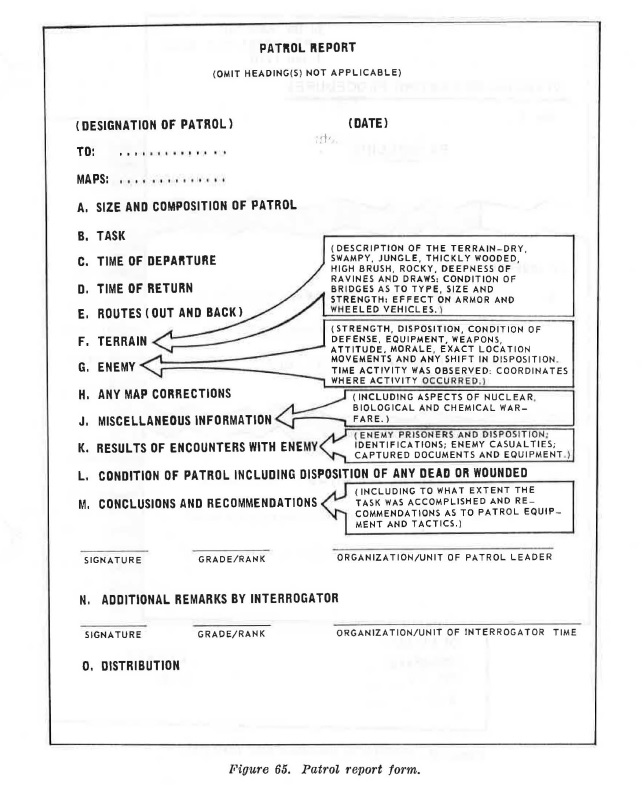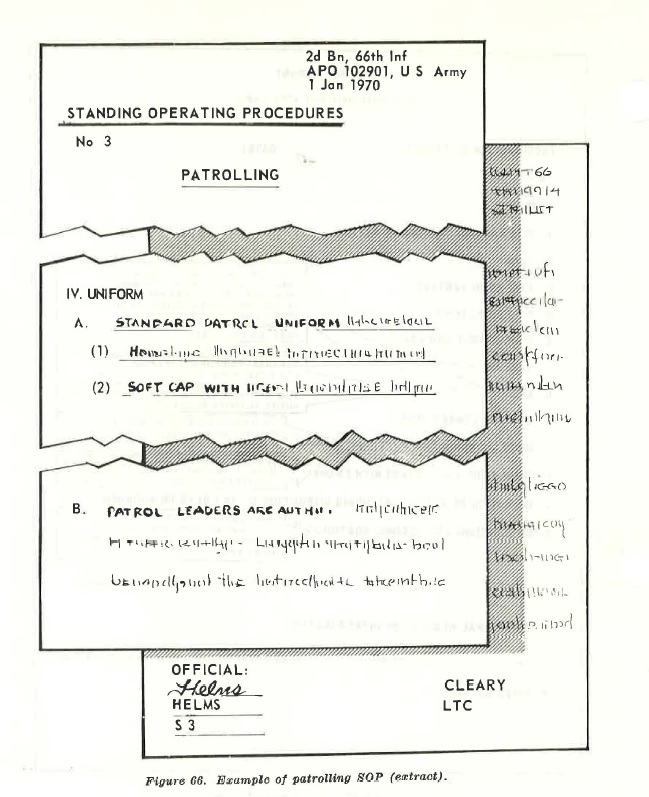Donate
| SECTION I | ---------------------------------- | GENERAL |
114. Command Responsibility
a. Commanders at all levels, from squad leader up, including patrol leaders, are responsible for:
(1) Training in patrolling.
(2) Coordination.
(3) Support.
(4) Supervision.
b. Commanders dispatching patrols are also responsible for:
(1) Formulation of patrol missions.
(2) Issuance of necessary orders to patrol leaders.
(3) Establishment of appropriate control measures.
(4) Debriefing.
(5) Dissemination of information obtained by patrols.
c. Commanders providing patrols are also responsible for:
(1) Selection of patrol leaders.
(2) Assisting higher and lower commanders, including patrol leaders, in every way possible.
d. Patrol leaders are also responsible for:
(1) Detailed planning and preparation of their patrols.
(2) Execution of assigned missions.
(3) Prompt and accurate reporting of results of patrols.
115. Staff Responsibility.
At battalion level and higher, many of the functions necessary to accomplish command responsibilities in patrolling are performed by staff officers. In companies and small units operating independently or semi-independently, these functions are performed by selected subordinates.
116. Command and Staff Actions
a. Training in Patrolling.
The operations officer (S3), with staff responsibility for all training, is assisted by he intelligence officer (S2) in training in patrolling. They work together closely in preparing programs and exercises which insures proper training in the principles and techniques of patrolling.
b. Selection of Patrol Leaders.
In training, the unit commander insures that his NCOs and junior officers are properly trained by rotating them in duties as patrol leaders. In combat, the commander or leader (company, platoon, squad, or patrol base) bases selection of patrol lenders on the requirements of assigned missions. Consistent with these requirements, he rotates duty as patrol leader among available NCOs and officers and avoids excessive use of a selected few.
c. Formulation of Patrol Missions.
The S9 formulates missions for reconnaissance patrols; the $3 formulates missions for combat patrols. They consider the capabilities of each type of patrol.
(1) Reconnaissance patrols are capable of:
(a) Point reconnaissance and surveillance.
(b) Area reconnaissance and surveillance.
(c) Route reconnaissance.
(2) Combat patrols are capable of:
(a) Raids, to destroy or capture personnel or equipment, destroy installations, or liberate personnel.
(b) Ambush of such targets as patrols, carrying parties, wire repair teams, convoys, and foot columns.
(c) Targets of opportunity missions, especially in counter guerrilla operations.
(d) Economy-of-force missions, to seize features such as bridges, hills, and road junctions.
(e) Contact missions, to establish or maintain contact, or both, with friendly or enemy forces.
(f) Security missions, especially local security to detect and prevent infiltration and to prevent surprise and ambush.
d. Assignment of Patrol Missions.
(1) Recommendations for patrols to be conducted and the units to provide the patrols are submitted to the commander for his approval.
(2) A patrol is assigned only one mission. The essential tasks required to accomplish the mission are the tasks of the elements and teams of the patrol.
(3) The mission may be very specific; for example, "Destroy the enemy OP on Hill 208," or it may be general; e.g., a search and attack patrol might be assigned the mission to "locate and, within capability, destroy any guerrilla forces in Area D"
(4) Whether specific or general, the mission must be clearly stated, thoroughly understood, and within the capabilities of the patrol.
e. Orders to the Patrol Leader.
Orders providing the patrol leader the information, instruction, and guidance necessary to enable him to plan, prepare, and conduct the patrol are usually issued orally, either as an informal briefing or as a standard operation order.
(1) Orders for frequently recurring patrols of a routine nature are issued as concise, informal briefings. Local security patrols and patrols establishing and/or maintaining contact with nearby friendly units are examples. These patrols require minimum preparation and relatively little specific information, instructions, and guidance.
(2) Orders for non-routine patrols, commonly those dispatched by battalions and higher units, are issued as standard operation orders. The officer having staff responsibility for the type of patrol (reconnaissance-S2, combat-S3) issues the order, with other staff members presenting briefings on matters related to their areas of responsibility.
f. Coordination.
(1) Coordination is a continuing, joint effort by the commander's staff and the patrol leader. The three general areas of coordination are between the:
(a) Staff and staffs of other units.
(b) Staff and the patrol leader.
(c) Patrol leader and units or personnel immediately affected by the patrol's operation.
(2) Coordination in these general areas frequently overlaps in insuring that coordination is continuous, complete, and properly accomplished. This is particularly true of long-range patrols since the dispatching unit's areas of influence and interest may overlap those of other units.
g. Control.
The commander dispatching a patrol is limited in the degree of control he can exercise over the patrol after it has departed friendly areas. The means for a having the desired degree of control must be included in the orders issued to the patrol leader.
(1) Time of departure and/or return may be stated in general terms, such as "Leave (or return) after dark," or Leave (or return) before daylight." Specific times may be given to prevent congestion in an area, reduce possibility of contact between patrols, and provide strict control. Information secured by a reconnaissance patrol may lose its value if not received by a certain time, or future operations may hinge on the results of a combat patrol. Similarly, a patrol may be required to accomplish its mission at, or within, a certain time. For example, a patrol may be required to destroy a communications center at, or by, a certain time in order to assist a planned attack. "When there is a reasonable chance that, despite its best efforts, a patrol will not be able to accomplish the mission and comply with time restrictions, the order must state which has priority accomplishment of the mission or compliance with time limitations.
Normally, accomplishment of the mission has first priority, but determination of priority is the commander's responsibility.
(2) Checkpoints may be used as a control measure by requiring the patrol to report upon reaching the vicinity of a checkpoint.
(3) Route may be generally defined or specifically prescribed.
(a) General route may be defined by a series of checkpoints over or near which the patrol is required to pass.
(b) Exact route is seldom prescribed, except in route reconnaissance or when close control of movement is desired.
(4) Point of departure of friendly areas may be prescribed.
(5) Point of re-entry of friendly areas may be prescribed. Re-entry at point of departure may be directed or, to reduce danger of ambush, re-entry at a different point may be specified.
(6) The communications plan specifies reports to be made and methods of transmission. Radio is usually the best means, with the type of radio used determined by the distance the patrol must travel, availability of radios, field expedient antennas, qualified operators, and method of movement.
(a) Simple prearranged codes and code words are used to reduce transmission time and decrease the possibility of compromising the mission.
(b) Pyrotechnics (flares or smoke) may also be used, but they increase possibility of detection.
(c) Prearranged code words or pyrotechnics may be used to indicate departure of friendly areas, arrival at checkpoints, accomplishment of mission, or other desired information.
(d) Messengers may be used in some situations. They are the only means for sending back written material, items of equipment, and prisoners.
h. Support.
(1) The S3 makes rehearsal areas available and assists in coordination in all areas.
(2) The S4 provides equipment not available in the patrol's unit.
(3) The S2 and S3 arrange for specially qualified personnel such as linguists, guides, scout dog teams, demolitions specialists, and pathfinder or terminal guidance personnel.
(4) The fire support coordinator (FSCOORD) assists the patrol leader in planning effective fire support for the patrol.
i. Supervision. This is provided by all commanders and staff officers. They actively supervise all phases of patrol planning and preparation, including rehearsals, giving patrols the benefit of their own training and experience.
j. Debriefing.
(1) On return, patrols are debriefed by the S2 or his representative. Techniques used in debriefing vary. One effective method is for the patrol leader to give a narrative account of the patrol from departure to return. Each patrol member then contributes any additional information he has. The debriefer asks questions to secure desired information not covered. Whatever the technique used, all patrol members are given the opportunity to add to information reported.
(2) The patrol report form shown in figure 65 is used to help insure complete debriefing. This is the standard form adopted by most of the NATO countries and its use is required in the U.S. Army (STANAG No. 2003). When reproduced, with adequate space for entering information, several pages are required. (Users must note that the letter "I" is not used as an item heading.)
k. Use of SOPB. Standing Operating Procedures (SOPs) can be very effectively used at all levels to simplify patrolling operations, especially planning by the patrol leader and preparation by patrol members. Following are a few items which may be appropriately established by SOP:
(1) Patrol uniform; The purpose of this is to standardize routine uniform and equipment and to eliminate the necessity for a long recitation of these items in orders. Additions, deletions, or changes necessitated by weather, mission, or other factors are stated as, ,"patrol uniform, plus field jacket"; patrol uniform, minus bayonet and scabbard" or "patrol uniform, with sneakers instead of boots.'' The SOP description of the "patrol uniform" should be very specific, as indicated in figure 66.
(2) Equipment. Prescribing minimums of certain items and, in some cases, who will carry them insures proper equipage of patrols. For example:

Figure 65. Patrol report form.
(a) Three pairs of binoculars (carried by patrol leader, assistant patrol leader, and point). Prescribing the manner in which binoculars will be carried may help prevent their loss.
(b) Two pairs of wire cutters ( carried by compass man and point).
(3) Preparation of weapons. For example:
(a) Test firing of weapons.
(b) Camouflage of weapons, to include taping of slings.
(c) Use of rope or extra slings on machine guns and other automatic weapons, so they can be carried "at the ready" and fired accurately while moving.

Figure 66. Example of patrolling SOP (exact).